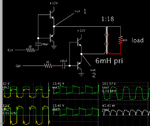artmaster547
Newbie level 4
Hi All
I am currently trying to simualte/design a power converter that takes in 12V and outputs +175V and -175V AC sinusoidal output (delivering a maximum power to the load of ~40W a little less than this) Can anyone suggest a good topology that I should use for this any recommendations are warmly welcome I just need a starting point to work from. The output AC waveform will also need the ability to change frequency.
Kind Regards
Art
I am currently trying to simualte/design a power converter that takes in 12V and outputs +175V and -175V AC sinusoidal output (delivering a maximum power to the load of ~40W a little less than this) Can anyone suggest a good topology that I should use for this any recommendations are warmly welcome I just need a starting point to work from. The output AC waveform will also need the ability to change frequency.
Kind Regards
Art
